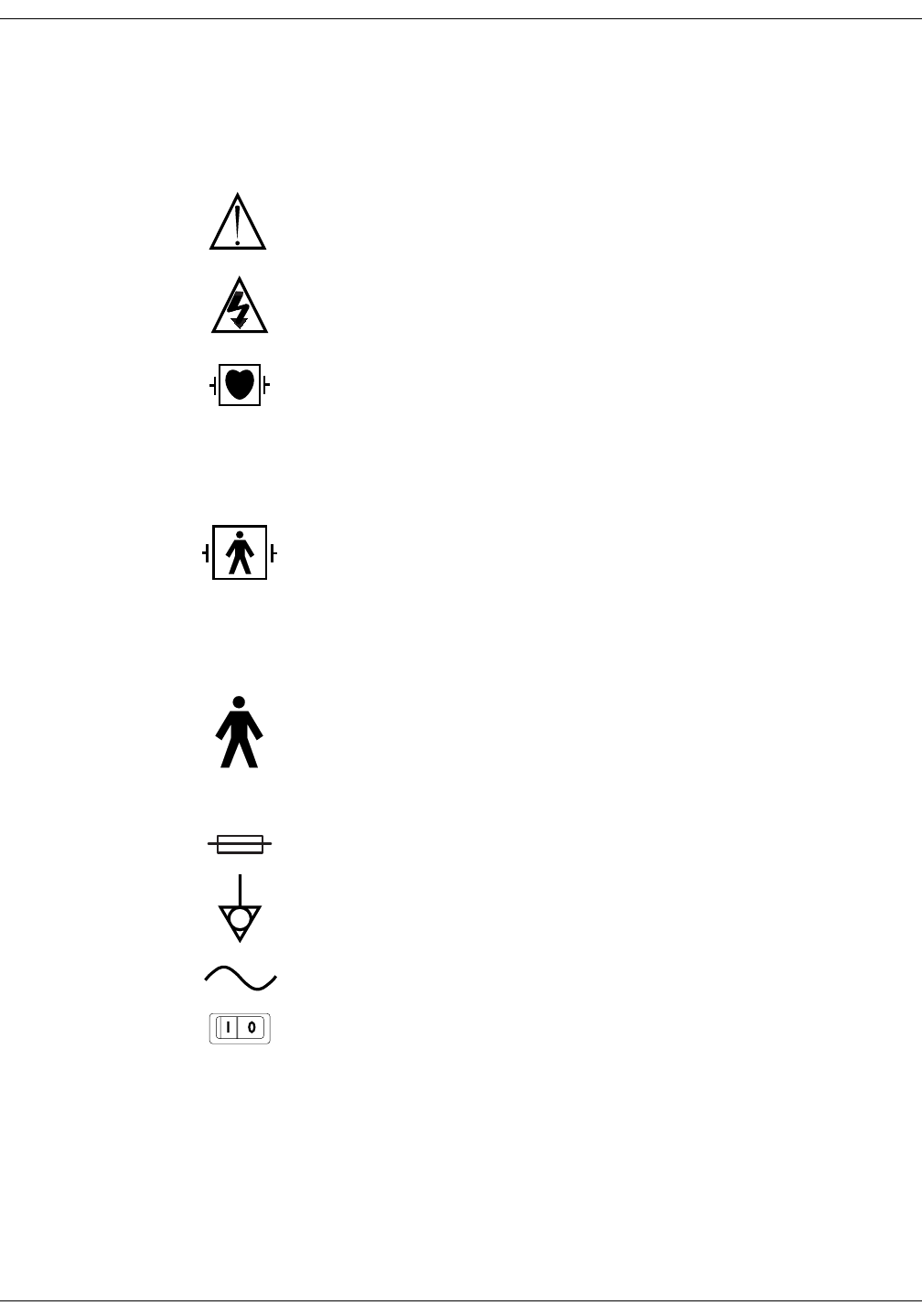GE Medical Systems Information Technologies 2014748 Medical Telemetry Transmitter worn on body User Manual 02Safety
GE Medical Systems Information Technologies Inc. Medical Telemetry Transmitter worn on body 02Safety
Contents
- 1. Users Manual 1 of 3
- 2. Users Manual 2 of 3
- 3. Users Manual 3 of 3 Safety
- 4. 2001989 135A APEX Manual DRAFT
Users Manual 3 of 3 Safety

Revision B ApexPro Telemetry System 2-1
2001989-134
2Safety

2-2 ApexPro Telemetry System Revision B
2001989-134
For your notes

Revision B ApexPro Telemetry System 2-3
2001989-134
Safety: For Your Safety
For Your Safety
Intended Use
The ApexPro Telemetry System is intended for use under the direct
supervision of a licensed healthcare practitioner. The system is designed
to acquire and monitor physiological data for ambulating patients within
a defined coverage area. The system processes this physiological data to
detect various ECG arrhythmia events and select physiological
parameter limit violations.
The ApexPro Telemetry System is intended to be installed in the hospital
or clinical environment in order to provide clinicians with patient
physiological data, while allowing for patient mobility. These systems
are typically deployed in sub acute care areas in hospitals or clinical sites
where patient mobility can enhance the effectiveness of the medical
procedures administered.
The physiological parameters monitored include ECG, non-invasive
blood pressure and SpO2. The ApexPro Telemetry System is intended to
provide ECG data via Ethernet to the computer platform for processing.
The ApexPro is also intended to provide physiologic data over the Unity
network to clinical information systems for display.
Definitions
The terms danger, warning, and caution are used throughout this
manual to point out hazards and to designate a degree or level or
seriousness. Familiarize yourself with their definitions and significance.
Hazard is defined as a source of potential injury to a person.
DANGER indicates an imminent hazard which, if not avoided, will
result in death or serious injury.
WARNING indicates a potential hazard or unsafe practice which, if not
avoided, could result in death or serious injury.
CAUTION indicates a potential hazard or unsafe practice which, if not
avoided, could result in minor personal injury or product/property
damage.
NOTE provides application tips or other useful information to assure
that you get the most from your equipment.

2-4 ApexPro Telemetry System Revision B
2001989-134
Safety: For Your Safety
System Safety
The safety statements presented in this chapter refer to the equipment
in general and, in most cases, apply to all aspects of the telemetry
system. There are additional safety statements in other chapters that are
specific to the information presented in that chapter.
The order in which safety statements are presented in no way implies
order of importance.
Dangers
There are no dangers that refer to the equipment in general. Specific
“Danger” statements may be given in the respective sections of this
manual.
Warnings
WARNINGS
ACCIDENTAL SPILLS — To avoid electric shock or
device malfunction liquids must not be allowed to enter
the device. If liquids have entered a device, take it out of
service and have it checked by a service technician before
it is used again.
ACCURACY — If the accuracy of any value displayed on
the monitor, central station, or printed on a graph strip is
questionable, determine the patient's vital signs by
alternative means. Verify that all equipment is working
correctly.

Revision B ApexPro Telemetry System 2-5
2001989-134
Safety: For Your Safety
WARNINGS
ALARMS — Do not rely exclusively on the audible alarm
system for patient monitoring. Adjustment of alarm
volume to a low level or off during patient monitoring
may result in a hazard to the patient.
Do not rely exclusively on the alarm pause breakthrough
feature for alarm notification during an alarm pause.
This may result in a hazard to the patient. Only crisis
alarms break through an alarm pause.
Remember that the most reliable method of patient
monitoring combines close personal surveillance with
correct operation of monitoring equipment.
After connecting the monitor to the central station, nurse
alert system, and/or network, verify the function of the
alarm system.
The functions of the alarm system for monitoring of the
patient must be verified at regular intervals.
BEFORE USE — Before putting the system into
operation visually inspect all connecting cables for signs
of damage. Damaged cables and connectors must be
replaced immediately.
Before using the system, the operator must verify that it
is in correct working order and operating condition.
Periodically, and whenever the integrity of the product is
in doubt, test all functions.
CABLES — Route all cables away from patient's throat
to avoid possible strangulation.

2-6 ApexPro Telemetry System Revision B
2001989-134
Safety: For Your Safety
WARNINGS
CONDUCTIVE CONNECTIONS — Extreme care must
be exercised when applying medical electrical equipment.
Many parts of the human/machine circuit are conductive,
such as the patient, connectors, electrodes, transducers.
It is very important that these conductive parts do not
come into contact with other grounded, conductive parts
when connected to the isolated patient input of the
device. Such contact would bridge the patient's isolation
and cancel the protection provided by the isolated input.
In particular, there must be no contact of the neutral
electrode and ground.
DEFIBRILLATION — Do not come into contact with
patients during defibrillation. Otherwise serious injury
or death could result.
DISCONNECTION FROM MAINS — When
disconnecting the system from the power line, remove the
plug from the wall outlet first. Then you may disconnect
the power cord from the device. If you do not observe this
sequence, there is a risk of coming into contact with line
voltage by inserting metal objects, such as the pins of
leadwires, into the sockets of the power cord by mistake.
DISPOSAL — Dispose of the packaging material,
observing the applicable waste control regulations and
keeping it out of children's reach.
EXPLOSION HAZARD — Do not use this equipment in
the presence of flammable anesthetics, vapors or liquids.
INTERFACING OTHER EQUIPMENT — Devices may
only be interconnected with each other or to parts of the
system when it has been determined by qualified
biomedical engineering personnel that there is no danger
to the patient, the operator, or the environment as a
result. In those instances where there is any element of
doubt concerning the safety of connected devices, the user
must contact the manufacturers concerned (or other
informed experts) for proper use. In all cases, safe and
proper operation should be verified with the applicable
manufacturer's instructions for use, and system
standards IEC 60601-1-1/EN 60601-1-1 must be complied
with.

Revision B ApexPro Telemetry System 2-7
2001989-134
Safety: For Your Safety
WARNINGS
LEAKAGE CURRENT TEST — When interfacing with
other equipment, a test for leakage current must be
performed by qualified biomedical engineering personnel
before using with patients.
NETWORK INTEGRITY — The clinical information
center resides on the hospital’s computer network, and it
is possible that inadvertent or malicious network activity
could adversely affect patient monitoring. The integrity
of the computer network is the responsibility of the
hospital.
POWER SUPPLY — The device must be connected to a
properly installed power outlet with protective earth
contacts only.
All devices of a system must be connected to the same
power supply circuit. Devices which are not connected to
the same circuit must be electrically isolated when
operated (electrically isolated RS232 interface).
Do not use this power unit in the presence of flammable
anesthetics.
PROTECTED LEADWIRES — Only use protected
leadwires and patient cables with this device. The use of
unprotected leadwires and patient cables creates the
potential for making an electrical connection to ground or
to a high voltage power source which can cause serious
injury or death to the patient.
Unprotected Leadwire Protected Leadwire
322C

2-8 ApexPro Telemetry System Revision B
2001989-134
Safety: For Your Safety
WARNINGS
RATE METERS — Keep pacemaker patients under close
observation. Rate meters may continue to count the
pacemaker rate during cardiac arrest and some
arrhythmias. Therefore, do not rely entirely on rate
meter alarms.
SITE REQUIREMENTS — For safety reasons, all
connectors for patient cables and sensor leads are
designed to prevent inadvertent disconnection, should
someone pull on them. Do not route cables in a way that
they may present a stumbling hazard. For devices
installed above the patient, adequate precautions must
be taken to prevent them from dropping on the patient.
Cautions
CAUTIONS
ACCESSORIES (SUPPLIES) — To ensure patient safety,
use only parts and accessories manufactured or
recommended by GE Medical Systems Information
Technologies.
Parts and accessories used must meet the requirements
of the applicable IEC 60601 series safety standards and
essential performance standards, and/or the system
configuration must meet the requirements of the IEC
60601-1-1 medical electrical systems standard.
ACCESSORIES (EQUIPMENT) — The use of
ACCESSORY equipment not complying with the
equivalent safety requirements of this equipment may
lead to a reduced level of safety of the resulting system.
Consideration relating to the choice shall include:
use of the accessory in the PATIENT VICINITY; and
evidence that the safety certification of the
ACCESSORY has been performed in accordance to
the appropriate IEC 60601-1 and/or IEC 60601-1-1
harmonized national standard.

Revision B ApexPro Telemetry System 2-9
2001989-134
Safety: For Your Safety
CAUTIONS
BEFORE INSTALLATION — Compatibility is critical to
safe and effective use of this device. Please contact your
local sales or service representative prior to installation
to verify equipment compatibility.
DEFIBRILLATOR PRECAUTIONS — Patient signal
inputs labeled with the CF and BF symbols with paddles
are protected against damage resulting from
defibrillation voltages. To ensure proper defibrillator
protection, use only the recommended cables and
leadwires.
Proper placement of defibrillator paddles in relation to
the electrodes is required to ensure successful
defibrillation.
DISPOSABLES — Disposable devices are intended for
single use only. They should not be reused as
performance could degrade or contamination could occur.
DISPOSAL — At the end of its service life, the product
described in this manual, as well as its accessories, must
be disposed of in compliance with the guidelines
regulating the disposal of such products. If you have
questions concerning disposal of the product, please
contact GE Medical Systems Information Technologies or
its representatives.
ELECTROCAUTERY PRECAUTIONS — To prevent
unwanted skin burns, apply electrocautery electrodes as
far as possible from all other electrodes, a distance of at
least 15 cm/6 in. is recommended.
ELECTRODES — Whenever patient defibrillation is a
possibility, use non-polarizing (silver/silver chloride
construction) electrodes for ECG monitoring. Polarizing
electrodes (stainless steel or silver constructed) may
cause the electrodes to retain a residual charge after
defibrillation. A residual charge will block acquisition of
the ECG signal.

2-10 ApexPro Telemetry System Revision B
2001989-134
Safety: For Your Safety
CAUTIONS
EMC — Magnetic and electrical fields are capable of
interfering with the proper performance of the device.
For this reason make sure that all external devices
operated in the vicinity of the monitoring system comply
with the relevant EMC requirements. X-ray equipment
or MRI devices are a possible source of interference as
they may emit higher levels of electromagnetic radiation.
INSTRUCTIONS FOR USE — For continued safe use of
this equipment, it is necessary that the listed
instructions are followed. However, instructions listed in
this manual in no way supersede established medical
practices concerning patient care.
LOSS OF DATA — Should the monitor at any time
temporarily lose patient data, the potential exists that
active monitoring is not being done. Close patient
observation or alternate monitoring devices should be
used until monitor function is restored.
Once monitoring is restored, you should verify correct
monitoring state and alarm function.
MAINTENANCE — Regular preventive maintenance
should be carried out annually. You are responsible for
any requirements specific to your country.
MPSO — The use of a multiple portable socket outlet
(MPSO) for a system will result in an enclosure leakage
current equal to the sum of all individual earth leakage
currents of the system if there is an interruption of the
MPSO protective earth conductor. Do not use an
additional extension cable with the MPSO as it will
increase the chance of the single protective earth
conductor interruption.
NEGLIGENCE — GE Medical Systems Information
Technologies does not assume responsibility for damage
to the equipment caused by improperly vented cabinets,
improper or faulty power, or insufficient wall strength to
support equipment mounted on such walls.

Revision B ApexPro Telemetry System 2-11
2001989-134
Safety: For Your Safety
CAUTIONS
OPERATOR — Medical technical equipment such as this
monitor/monitoring system must only be used by persons
who have received adequate training in the use of such
equipment and who are capable of applying it properly.
POWER REQUIREMENTS — Before connecting the
device to the power line, check that the voltage and
frequency ratings of the power line are the same as those
indicated on the unit's label. If this is not the case, do not
connect the system to the power line until you adjust the
unit to match the power source.
RESTRICTED SALE — U.S. federal law restricts this
device to sale by or on the order of a physician.
SECURITY — The web browser which runs in
conjunction with the clinical information center is
intended for hospital INTRANET use only. If confidential
patient information is made available from the hospital
intranet, the security of the data is the responsibility of
the hospital.
SUPERVISED USE — This equipment is intended for
use under the direct supervision of a licensed health care
practitioner.
UNINTENTIONAL RADIO FREQUENCY (RF)
INTERFERENCE — Unintentional RF interference
could degrade the reliability and performance of the
wireless data link. The facility must maintain an RF
environment free from unintentional interference. Refer
to the service manuals for more information.
VENTILATION REQUIREMENTS — Set up the device
in a location which affords sufficient ventilation. The
ventilation openings of the device must not be obstructed.
The ambient conditions specified in the technical
specifications must be ensured at all times.

2-12 ApexPro Telemetry System Revision B
2001989-134
Safety: For Your Safety
Notes
Put the system in a location where you can easily see the screen and
access the operating controls.
This product is not likely to cause abnormal operation of other
patient-connected equipment such as cardiac pacemakers or other
electrical stimulators. Exceptions are noted in the pacemaker
monitoring section, if applicable.
This product is protected against the effects of cardiac defibrillator
discharges to ensure proper recovery, as required by test standards.
This equipment is suitable for connection to public mains as defined
in CISPR 11.
This equipment is suitable for use in the presence of electrosurgery.
Reference Literature
Medical Device Directive 93/42/EEC.
EN 60601-1/1990 + A1: 1993 + A2: 1995: Medical electrical equipment.
General requirements for safety.
EN 60601-1-1:2001: General requirements for safety. Safety
requirements for medical electrical systems.
IEC Publication 513/1994: Fundamental aspects of safety standards for
medical equipment.
ROY, O.Z.: Summary of cardiac fibrillation thresholds for 60-Hz currents
and voltages applied directly to the heart. Med. & Biol. Engn. &
Computing 18: 657...659 (1980).

Revision B ApexPro Telemetry System 2-13
2001989-134
Safety: For Your Safety
Classification
The telemetry system is classified, according to IEC 60601-1, as:
Underwriters Laboratories, Inc.
Medical Equipment
With respect to electric shock, fire and mechanical hazards
only in accordance with UL 2601-1, and CAN/CSA C22.2
NO. 601.1 and if applicable, IEC 60601-2-27, IEC 60601-2-
30, and IEC 60601-2-49.
Type of protection against electrical shock Transmitter — Internally powered
Receiver system — Class I
Degree of protection against electrical
shock
ApexPro Transmitter — Type B applied part
ApexPro CH Transmitter—Type CF Defibrillation proof applied part (not for sale
outside of the U.S.)
Degree of protection against harmful
ingress of water
ApexPro Transmitter — IPX3 (IEC 60529)
ApexPro CH Transmitter — IPX7 (IEC 60529)-not for sale outside of the U.S.
Receiver system — Ordinary Equipment (enclosed equipment without protection
against ingress of water)
Degree of safety of application in the
presence of a flammable anesthetic
mixture with air or with oxygen or nitrous
oxide
Equipment not suitable for use in the presence of a flammable anesthetic mixture
with air or with oxygen or nitrous oxide
Method(s) of sterilization or disinfection
recommended by the manufacturer
Not applicable
Mode of operation Continuous operation

2-14 ApexPro Telemetry System Revision B
2001989-134
Safety: For Your Safety
FCC Compliance Information Statement
This equipment complies with Part 95 Subpart H of the FCC rules to be
used in wireless medical telemetry service. Operation of this equipment
requires prior coordination with a frequency coordinator designated by
the FCC for the Wireless Medical Telemetry Service. This device is also
certified for RSS-210 of Industry Canada.
Installation and maintenance of this transmitter should be performed by
a person certified as technically qualified to perform such operations.
Replacement of any transmitter component or modifications to the
transmitter could result in a violation of the rules. Changes or
modifications not expressly approved by the party responsible for
compliance could void the user’s authority to operate the equipment. Use
only GE Medical Systems approved replacement parts, non-approved
parts may result in a violation of the FCC rules.
RF Exposure
This device complies with FCC radiation exposure limits set forth for an
uncontrolled environment. The RF transmission power from the antenna
conforms to the general public FCC limit of Specific Absorption Rate
(SAR) 1.6 W/kg. The maximum SAR value measured from this device
was 0.01 W/kg. This device must not be co-located or operating in
conjunction with any other antenna or transmitter.

Revision B ApexPro Telemetry System 2-15
2001989-134
Safety: For Your Safety
Equipment Symbols
NOTE
Some symbols may not appear on all equipment.
ATTENTION: Consult accompanying documents.
CAUTION: To reduce the risk of electric shock, do NOT remove cover. Refer servicing to
qualified service personnel.
NOTE
The rating of
protection against
electric shock
(indicated by
symbol for CF or
BF) is achieved only
when used with
patient applied
parts recommended
by GE Medical
Systems
Information
Technologies.
TYPE CF APPLIED PART: Isolated (floating) applied part suitable for intentional external and
internal application to the patient including direct cardiac application. “Paddles” outside the
box indicate the applied part is defibrillator proof.
[Medical Standard Definition:] F-type applied part (floating/isolated) complying with the
specified requirements of IEC 60601-1/UL 2601-1/CSA 601.1 Medical Standards to provide a
higher degree of protection against electric shock than that provided by type BF applied parts.
TYPE BF APPLIED PART: Isolated (floating) applied part suitable for intentional external and
internal application to the patient excluding direct cardiac application. “Paddles” outside the
box indicate the applied part is defibrillator proof.
[Medical Standard Definition:] F-type applied part (floating/isolated) complying with the
specified requirements of IEC 60601-1/UL 2601-1/CSA 601.1 Medical Standards to provide a
higher degree of protection against electric shock than that provided by type B applied parts.
TYPE B APPLIED PART: Non-isolated applied part suitable for intentional external and
internal application to the patient excluding direct cardiac application.
[Medical Standard Definition:] Applied part complying with the specified requirements of IEC
60601-1/UL 2601-1/CSA 601.1 Medical Standards to provide protection against electric
shock, particularly regarding allowable leakage current.
Fuse
Equipotentiality
Alternating current (AC)
Power; I = ON; O = OFF

2-16 ApexPro Telemetry System Revision B
2001989-134
Safety: For Your Safety
Indicates where to press to open the door on the 7160 DDW.
Silence Alarms keyboard key.
PRESS